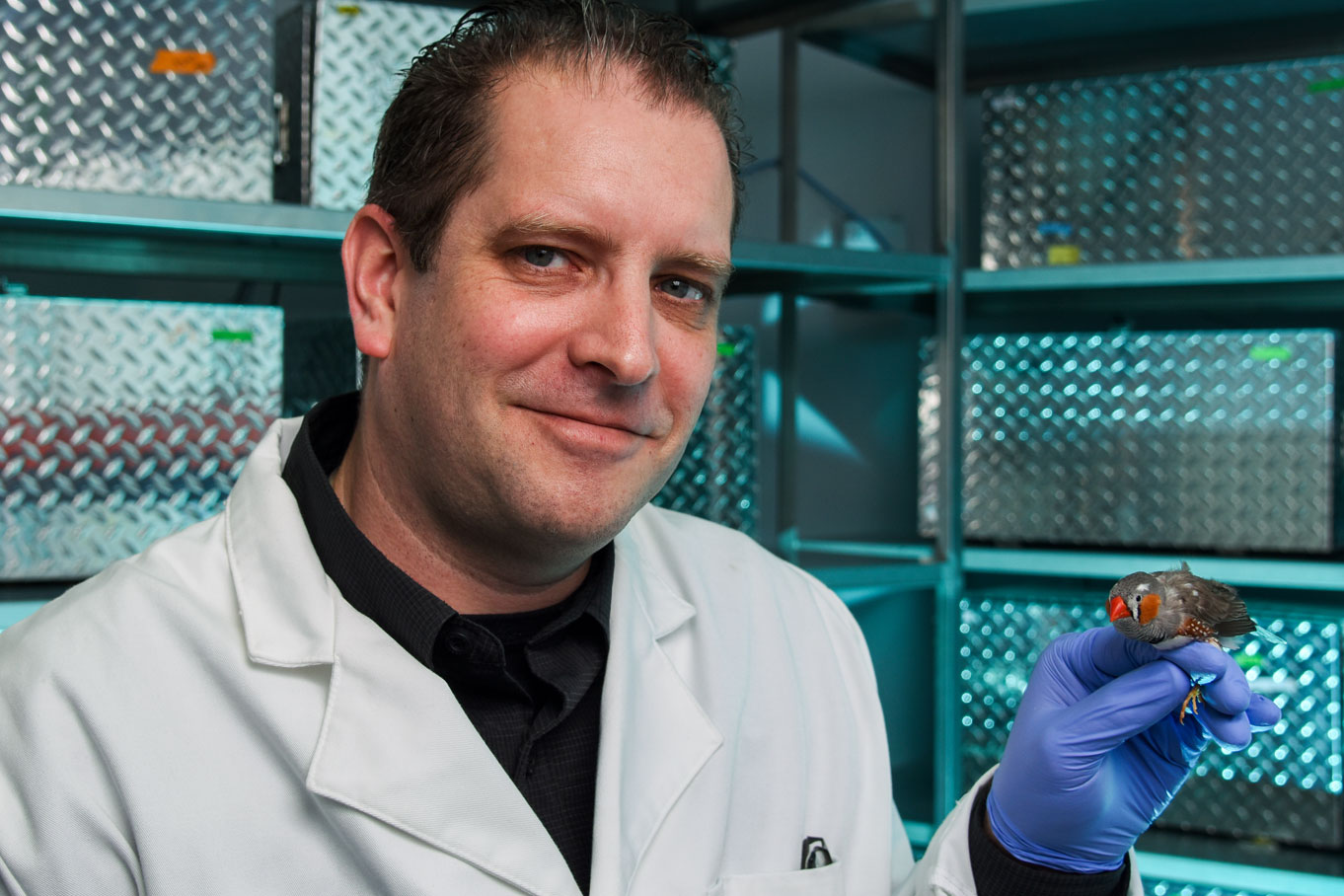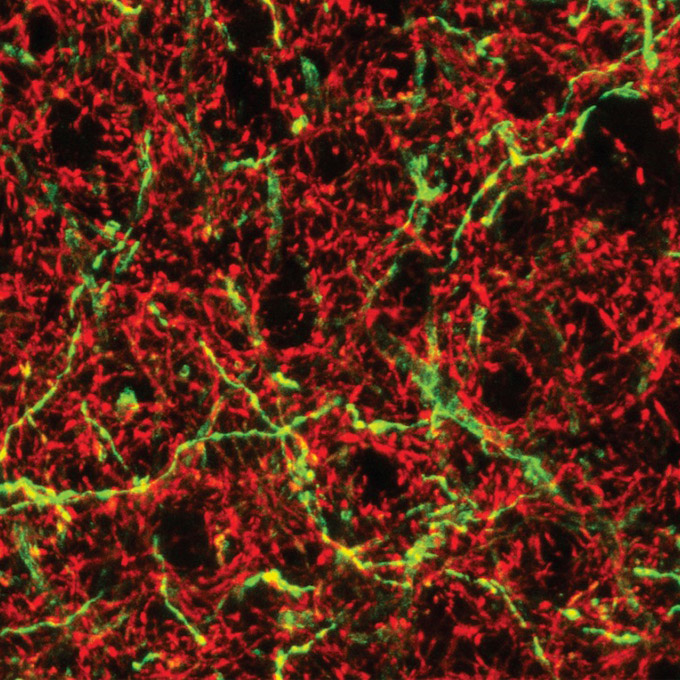In perfect harmony

Male zebra finches, small songbirds native to Australia, only learn a single song during their lifetimes. They memorize their father’s song and then practice it thousands upon thousands of times – to perfection.
This makes them an ideal subject to study how neurons guide the learning of vocal behaviors – research that has implications for stuttering and autism-spectrum disorders in humans, notes Dr. Todd Roberts, an Assistant Professor of Neuroscience in the Peter O’Donnell Jr. Brain Institute at UT Southwestern.
“When the birds are really young, they form a memory of their dad’s song and then they learn to copy it – with really high precision. This allows us to know and control exactly what a young bird is going to try to learn,” he says. “In a laboratory setting, we can take young birds and provide them with a song tutor that we choose so we know exactly what type of song they’re going to try to learn to sing, and we can precisely measure how well they do it. We can do this while also monitoring the activity of different networks in the brain to try to understand their contributions to this learning process.”
Finding parallels
Dr. Roberts’ interest in this line of research stems from his early childhood.
“My family moved to Brazil when I was about 6 months old, so I grew up learning English and Portuguese at the same time,” he says. “When I was about 7, my family moved back to the U.S. and I quickly stopped speaking Portuguese, but my sister – who is three years older than me – remained fluent.”
It became a running family joke that his parents and sister were still bilingual, but he wasn’t.
“There are strong parallels between how young songbirds learn their song and how young children learn speech and language.”
“Somehow this language just vanished from my mind. At one point in my life I knew how to do something perfectly – I was fluent in Portuguese – and then I forgot. So I always had this curiosity about speech and language,” he says. That experience sparked his interest in neuroscience in high school.
As a psychology undergraduate student at the University of Maryland, he worked in a lab studying brain networks to understand how parrots learn vocalizations from social experiences. “That launched my interest,” says Dr. Roberts, who completed his neuroscience Ph.D. in the same lab.
He joined UTSW’s Department of Neuroscience in 2013 after a postdoctoral fellowship at Duke University Medical Center, where he transitioned to the larger field of songbird study. “The circuitry in the songbird brain is not as complicated as in the parrot brain,” he says.
“Young songbirds and young children both have very adaptable brains, and there are strong parallels between how young songbirds learn their song and how young children learn speech and language. There are also very strong parallels between the organization of the brain networks that control speech and language learning in people and those that control song learning in birds,” he says.
In both humans and birds, learning vocalization requires highly interconnected networks between specific brain regions.
Simulating stuttering
In a 2018 study published in Neuron, Dr. Roberts and his team identified a brain network that was capable of informing a bird whether it was producing its song correctly. Using voice detection algorithms that work in real time as the bird sings, the researchers can detect exactly what the bird is singing and how, and they can then provide feedback by manipulating a specific set of connections, called synapses, between brain cells.

“If we turn up the activity in those synapses, it tells the bird that it’s singing that part of its song correctly. And if we turn down the activity of those synapses, it tells the bird that it’s doing it incorrectly. By doing this, we can teach the birds how to change their songs over time in a predictable way – showing for the first time a set of specific connections in the brain that provide feedback during behavior on whether or not the performance of vocalizations is correct,” Dr. Roberts says.
The researchers were also able to mimic stuttering by turning the activity in those same synapses way up. “If we overactivate this set of synapses while birds are practicing their song over the course of several days, we can cause the birds to start to abnormally repeat certain syllables in their song in a way that closely reflects stuttering behavior in people.” While this mimics one feature of stuttering, it’s been unclear whether songbirds could be used as a model system to identify specific sets of brain networks that – when disrupted – completely mimic all symptoms of speech disorders in people. The Roberts lab is working on this problem now.
Dr. Roberts and his team are also trying to understand which speech-related genes might be expressed in the brain network that controls speech and stuttering. The researchers have developed tools that enable them to manipulate a gene in this network that shows strong parallels to the FOXP2 speech gene in people. Rare mutations in that gene are linked to difficulties in word production and comprehension. “We find that if we turn down expression of FoxP2 (the bird version of the gene), we can also drive stuttering-like behavior in songbirds and then correct these disruptions in song by turning the expression of that gene back up just in this one network of the brain.”
Disrupting memories
In two other studies, the researchers are trying to identify the pathways in the brain that allow young birds to form memories of the song they want to imitate. The long-term goal of this research is to identify connections in the cortex that help a young bird encode memories of its father’s song.
“We are very curious how this relates to kids who have FOXP1 syndrome. It could indicate that the reason they have trouble learning speech and language is that they can’t form memories of what speech and language sound like.”
Dr. Roberts and his team are trying to understand how genes that have been associated with neurodevelopmental disorders affect speech and language learning in people – particularly genes associated with autism spectrum disorders such as the FOXP1 gene. FOXP1 syndrome, which is considered rare, causes severe disruptions in the ability to learn speech and language.
“If we manipulate this gene by reducing its expression in young birds, then we end up having very specific disruptions in their ability to learn songs – which we think may have important implications in autism spectrum disorders associated with FOXP1.”
Manipulating this gene in young birds disrupts their ability to form a memory of their father’s song, but it does not disrupt their ability to imitate their father’s song if they already had a memory, the researchers found.
“So it really disrupts the social transmission or cultural transmission of information from the tutor to the pupil,” Dr. Roberts says. “We are very curious how this relates to kids who have FOXP1 syndrome. It could indicate that the reason they have trouble learning speech and language is that they can’t form memories of what speech and language sound like.”
Gaining momentum
Rather than any one specific breakthrough in his lab, Dr. Roberts is most excited about the convergence of basic science efforts to understand the organization and function of brain networks involved in learning and producing vocalizations with more translational research related to FOXP1 and FOXP2 genes.
“The more translational research is informing the more basic research, and the more basic research is helping us design better experiments for the translational research. Separate projects in the lab that have been running along parallel tracks are now converging, and we feel like they are starting to give us a clearer understanding of how the brain is organized, how vocalizations are learned early in development, and how their production is controlled later in adulthood,” Dr. Roberts says.
He is also amazed at the fast pace of progress in his studies on neural networks associated with stuttering and autism spectrum disorders.
“I think we felt both of these projects were completely beyond our grasp as recently as three years ago. It’s remarkable how quickly they’ve emerged thanks to the very hard work of talented young scientists in the laboratory, being able to work with collaborators at UT Southwestern, the rapidly evolving technologies we have available to us, and also just our ability to better manipulate genes in the songbird brain,” he adds.
Dr. Roberts is a Thomas O. Hicks Scholar in Medical Research.

